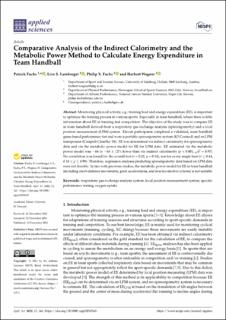| dc.contributor.author | Fuchs, Patrick | |
| dc.contributor.author | Fuchs, Philip X. | |
| dc.contributor.author | Wagner, Herbert | |
| dc.contributor.author | Luteberget, Live Steinnes | |
| dc.date.accessioned | 2022-03-22T21:11:54Z | |
| dc.date.available | 2022-03-22T21:11:54Z | |
| dc.date.created | 2022-02-11T12:27:57Z | |
| dc.date.issued | 2022 | |
| dc.identifier.citation | Applied Sciences. 2022, 12(1), Artikkel 163. | en_US |
| dc.identifier.issn | 2076-3417 | |
| dc.identifier.uri | https://hdl.handle.net/11250/2986918 | |
| dc.description | This article is an open access article distributed under the terms and conditions of the Creative Commons Attribution (CC BY) license (https://creativecommons.org/licenses/by/4.0/). | en_US |
| dc.description.abstract | Monitoring physical activity, e.g., training load and energy expenditure (EE), is important to optimize the training process in various sports. Especially in team handball, where there is little information about EE in training and competition. The objective of the study was to compare EE in team handball derived from a respiratory gas exchange analysis (spiroergometry) and a local position measurement (LPM) system. Eleven participants completed a validated, team handball game-based performance test and wore a portable spiroergometry system (K5 Cosmed) and an LPM transponder (Catapult ClearSky T6). EE was determined via indirect calorimetry for spiroergometry data and via the metabolic power model for EE for LPM data. EE estimated via the metabolic power model was −66 to −63 ± 12% lower than via indirect calorimetry (p < 0.001, pη2 = 0.97). No correlation was found for the overall test (r = 0.32, p = 0.34), nor for every single heat (r ≤ 0.44, 0.18 ≤ p ≤ 0.99). Therefore, regression analyses predicting spiroergometry data based on LPM data were not feasible. In line with previous studies, the metabolic power model for EE in team handball (including short-distance movements, great accelerations, and non-locomotive actions) is not suitable. | en_US |
| dc.language.iso | eng | en_US |
| dc.subject | local position measurement system | en_US |
| dc.subject | oxygen uptake | en_US |
| dc.subject | respiratory gas exchange analysis system | en_US |
| dc.subject | specific performance testing | en_US |
| dc.title | Comparative analysis of the indirect calorimetry and the metabolic power method to calculate energy expenditure in team handball | en_US |
| dc.type | Peer reviewed | en_US |
| dc.type | Journal article | en_US |
| dc.description.version | publishedVersion | en_US |
| dc.rights.holder | © 2021 by the authors | en_US |
| dc.source.pagenumber | 10 | en_US |
| dc.source.volume | 12 | en_US |
| dc.source.journal | Applied Sciences | en_US |
| dc.source.issue | 1 | en_US |
| dc.identifier.doi | 10.3390/app12010163 | |
| dc.identifier.cristin | 2000473 | |
| dc.description.localcode | Institutt for fysisk prestasjonsevne / Department of Physical Performance | en_US |
| dc.source.articlenumber | 163 | en_US |
| cristin.ispublished | true | |
| cristin.fulltext | original | |
| cristin.qualitycode | 1 | |
